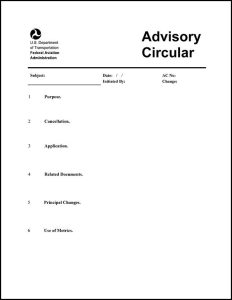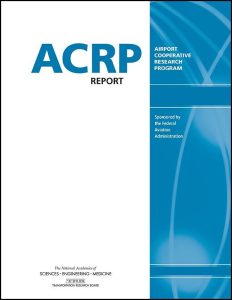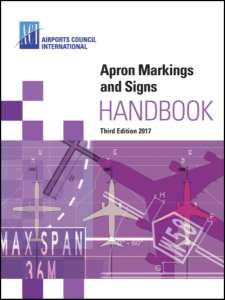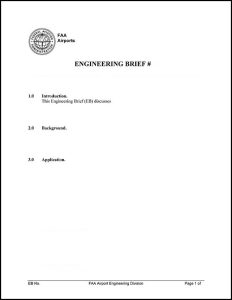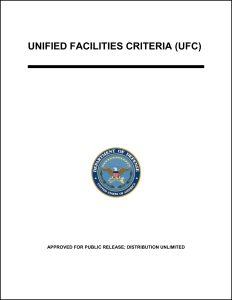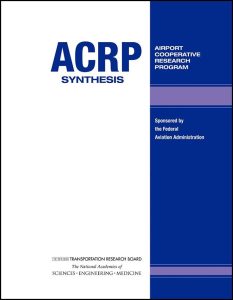To narrow the library of airside resources, use the filter boxes or airport map below or search box above.
Click an item below to expand.
Resources Matching Your Search
2020
This advisory circular (AC) contains FAA standards for the siting and installation of signs on airport runways and taxiways. Airport sign systems provide visual cues to pilots and vehicle operators, and enhance safe and efficient movement within the airfield. Elevated signs protect aeronautical surfaces and convey ground navigation information that enhances situational awareness when maneuvering on the airfield. The standards of this AC establish uniformity of sign systems throughout the National Airspace System (NAS) for consistent application and interpretation.
2021
This resource is a webpage that provides information on the Electronic Code of Federal Regulations (e-CFR) Title 14, Chapter I, Subchapter G, Part 139, which contains guidance on certification, airport certification manual, and operations.
2017
This advisory circular (AC) sets forth guidelines for operational safety in airports during construction. This AC assists airport operators in complying with Title 14 Code of Federal Regulations (CFR) Part 139, Certification of Airports. For those certificated airports, this AC provides one way, but not the only way, of meeting those requirements. The use of this AC is mandatory for those airport construction projects receiving funds under the Airport Improvement Program (AIP). Chapters include planning an airfield construction project, construction safety phasing plans (CSPP), and guidelines for writing a CSPP. Included in the appendices are a safety and phasing checklist and a construction project daily safety inspection checklist.
2013
ACRP Report 96 provides best practices for planning, designing, and marking apron areas for all sizes and types of airports in the United States. Apron planning and design considerations include facility geometrics, aircraft maneuvering, apron/airfield access points, operational characteristics, markings, lighting, and aircraft fleets. The report summarizes apron planning and design best practices for incorporating flexibility, increasing efficiency, and enhancing the safety of apron facilities.
2017
This updated version of the Apron Markings and Signs Handbook includes best practices for the application and maintenance of paint markings on aprons. The aim of the handbook is to promote the commonality of markings worldwide and the increasing acceptance and application of these practices, leading to a safer apron environment. These markings and signs supplement those provided in ICAO Annex 14, Volume I, and the ICAO Aerodrome Design Manual, Part 4 (Visual Aids). This resource is available from the ACI store for $180 for members and $1,000 for non-members.
2015
The purpose of the ACI Apron Safety Handbook was to update and expand Chapter 2 of the Airside Safety Handbook (fourth edition). Aprons are the most congested and busiest areas of an airport, with complex activities that are carried out under severe space and time constraints. This handbook provides best practices for planning and designing apron layouts and facilities. It also provides standard operational practices for safe apron operations as well as mitigation and prevention measures for maintenance and construction activities on aprons. This resource is available from the ACI store for $125 for members and $1,000 for non-members.
2014
This advisory circular (AC) provides the FAA-recommended guidelines for the maintenance of airport visual aid facilities. It provides system maintenance information for establishing a preventive maintenance program for airport visual aid facilities. The information provided is for the following systems: airport lighting vault and series lighting circuits, constant current regulators, runway and taxiway elevated edge lighting systems, runway and taxiway in-pavement lighting systems, runway guard lights and stop bar lights, illuminated runway and taxiway signs, rotating beacons, lighted wind cone assemblies, precision approach path indicator (PAPI) system, visual approach slope indicator (VASI), runway end identifier lights (REIL) and omni directional approach light system (ODALS), medium intensity approach light system (MALS, MALSF, MALSR), airfield lighting control and monitoring system (ALCMS), runway status lights (RWSL), obstruction lights, control systems, standby power engine generator systems.
2015
This advisory circular (AC) contains the FAA specifications for unlighted and lighted signs to be used on taxiways and runways. Six types of signs are specified in any of five sizes, five styles, and two classes, with any exceptions noted.
2020
Engineering Brief (EB) 100A addresses the FAA's recent completion of a safety risk assessment of the proposed modifications to the instrument departure surface described in FAA Order 8260.3, United States Standard for Terminal Instrument Procedures (TERPS). This EB provides approval for airport operators to implement the new departure surface for locating holding positions on the airfield.
2020
This advisory circular (AC) describes the standards and provides guidance in the development of a surface movement guidance and control system (SMGCS) plan for U.S. airports, in which scheduled air carriers are authorized to conduct operations when the visibility is less than 1,200 feet runway visual range (RVR). An SMGCS plan facilitates the safe movement of aircraft and vehicles on the airport by establishing more rigorous control procedures and requiring enhanced visual aids.
2020
This manual provides standardized airfield, heliport, and airspace criteria for the geometric layout, design, and construction of runways, helipads, taxiways, aprons, landing zones (LZs), short takeoff and vertical landing (STOVL) facilities, unmanned aircraft system (UAS) facilities, and related permanent facilities to meet sustained operations for U.S. Army, Navy, Air Force, and Marine Corps airfields.
2014
This advisory circular (AC) contains a specification for constant current regulators (CCRs) and monitors for use with airport lighting circuits.
2017
Part 5 discusses the general features of electrical practices and installations, and also addresses features that are of special significance for airport installations. It is assumed that the readers of the manual will be familiar with electrical circuits and design concepts, but may not be familiar with certain features of airport installations that are less frequently encountered in other installations. This resource is available at the ICAO store for $179.
2015
ACRP Report 148 provides advice for operating and maintaining LED airfield ground lighting systems, including taxi guidance signs, elevated light fixtures, and in-pavement light fixtures. This report will be of particular interest to airport operation and maintenance practitioners seeking to maximize the potential operation and maintenance benefits that LED lighting offers as they integrate and/or replace older airfield lighting with this new technology.
2012
ACRP Synthesis 35 documents the performance of LED airfield lighting systems. The report is intended for airfield operations managers and airport electrical maintenance staff. Information about LED lighting systems in terms of performance, cost, and other operations issues is not readily found in a single location. This report is an effort to gather information about airport experiences and feedback with LED airfield lighting.
2013
ACRP Synthesis 49 highlights comprehensive safety and security training resources as well as successful practices for new maintenance hires at general aviation airports. The objectives are to locate information on training new hires, identify current practices and challenges, document core training elements and resources, and identify resources that may help raise knowledge and understanding on the airport campus and its operating environment.
2021
This advisory circular (AC) contains the specifications for the frangible connections used to support objects in airfield safety areas.
